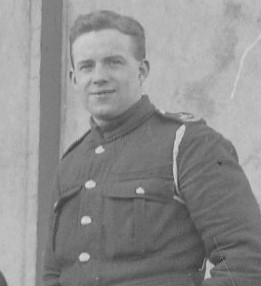
Mairi Featherstone visited the museum to see if we could find out a little about her grandfather, David Logan’s First World War service.
After a some investigation, it became clear that he had been in the Royal Field Artillery. On of the original postcards revealed that he had been at Scotton Camp (it is inscribed with “Cooks and Waiters, Sergeant’s Mess, Scotton Camp, Yorks 19/6”), which was eventually absorbed into Catterick Camp during the war. No 5 TF Artillery Training School was based at Scotton Camp in 1915, which is the most probable reason for his time there.
David’s medal card shows that he was in France by May 1915. There are two regimental numbers on his medal card, an early number, 971 referring to the Territorial Force RFA and a second reference 645569.
645569 Gunner David Logan was entitled to the 1915 Star, the British War Medal and the Victory Medal at the end of his war service.

An unusual group photograph – David is on the right

David Logan at Scotton camp
Explore more memories from the ribbon
-
Jack Morley
Mrs Drury of Richmond visited the museum to tell us about Jack Morley, her great uncle. Jack Morley was one of nine children of a hill farmer in Weardale, County Durham and a keen athlete. In 1914 he lived in Toronto, Canada whither he had emigrated and worked as a cabinet maker. When war broke out he returned to England, to his mother’s great joy, to join up in the Durham Light Infantry. One of his five brothers was Customs and Exciseman for Swaledale and Wensleydale, based in Richmond, near Catterick Camp where Jack did some training. Jack would ride over to Richmond to visit and would tie up his horse in the garden to the great delight of his nieces! Jack served in the 1915-1917 Salonica Campaign in northern Greece, at the time that city was badly burned. Jack organized the transport of supplies, mainly by mules through the hills up to the Struma Front. His height was 6’3” and together with his high-heeled riding boots and his high officer’s helmet, he made a commanding figure in securing the co-operation of the locals! In his time off he enjoyed shooting in the nearby Vardar Estuary marshes and brought home fine striped woollen socks run through with silver thread. The stamps from the postcards he sent home are still in a family stamp collection.
-
Thomas Cole
Submitted by Olivia Wallis of Richmond. Thomas Cole, son of Ben and Jane Cole, was born in Gainford, Durham in 1882, though the farming family resided in the local village of Newsham. On 9th June 1906, Thomas married Margaret Ellen Watson in St Cuthbert’s Church, Durham and, by 1911, Thomas and Margaret were the parents of Thomas, aged 3, Mary, aged 2, and Ben, aged only 11 months. Following the outbreak of war, though the exact date uncertain, Thomas enlisted at the neighbouring village of Dalton, and joined the 9th Battalion of the Yorkshire Regiment. Throughout his time with the 9th Battalion, Thomas wrote often to his devoted wife and children. In October 1916, Thomas wrote to tell his wife that he had become teetotal, news he expected to surprise his wife, explaining ‘I can’t drink French beer!’ Perhaps more poignantly, Thomas also expressed to Margaret his hopes of the future and a hope that future generations would never suffer the horrors of war. Thomas never got to pursue his hopes, he was killed on 23rd June 1917, aged 35. The battalion war diary for 23rd June does not detail events of that day, it simply collates casualties for the month as 6 men killed, 1 wounded and 2 missing. Private Thomas Cole is buried at Dickebusch New Military Cemetery, Belgium and commemorated locally on the war memorial in Newsham village.
-
Regimental Chapel, St Mary’s Church
In 1930 St Mary’s Parish Church offered the Lady Chapel as a memorial chapel for the Green Howards. This gift recognised that for over a century St Mary’s had been the garrison church for the regiment. The church already held the Green Howard’s Book of Remembrance for those who had been killed in the First World War, the regiment’s old Colours (Regimental flags) and many individual memorials. Fundraising began in 1931 but the economic depression made for a very challenging campaign. In August £386 had been raised but in September the regimental magazine noted, ‘Subscriptions to the Chapel fund have been most disappointing. In view of the present depressing state of the country this is not altogether surprising, but the Committee most earnestly appeal to all Green Howards to do their utmost to assist in completing the Chapel as a tribute to those whose memory it will perpetuate.’ The cry for assistance was heard and by the end of 1931 a date of Sunday, March 13th 1932 had been set for the dedication of the Chapel. The dedication service was led by the Bishop of Ripon. In his sermon he praised the Green Howards for providing a, ‘special place of prayer. It was a reminder that the war has a spiritual and Godward side, and taught them, among other things, the hopelessness of materialism as a way of life.’ As well as housing the Book of Remembrance the chapel also includes a number of items given in memory of soldiers…
